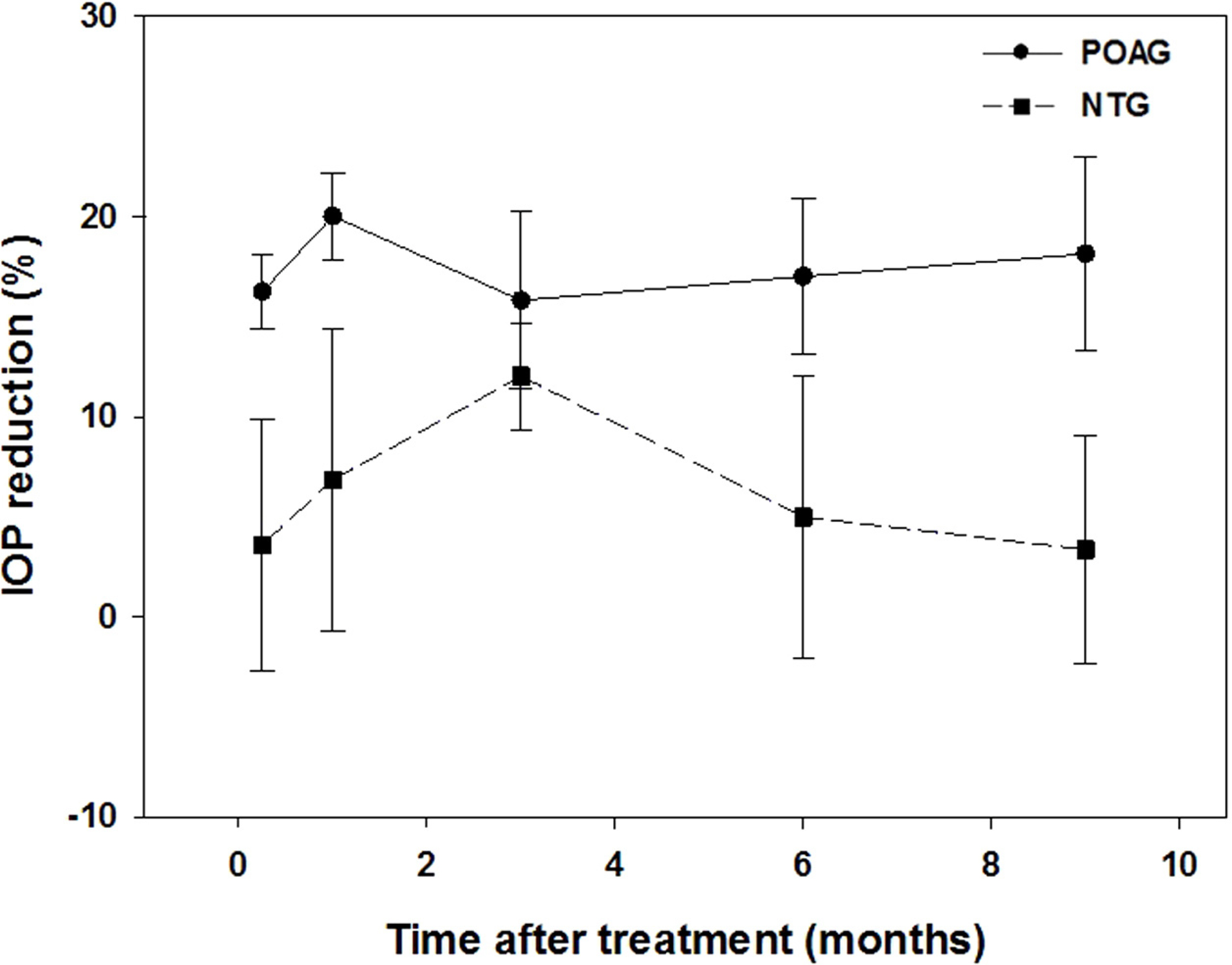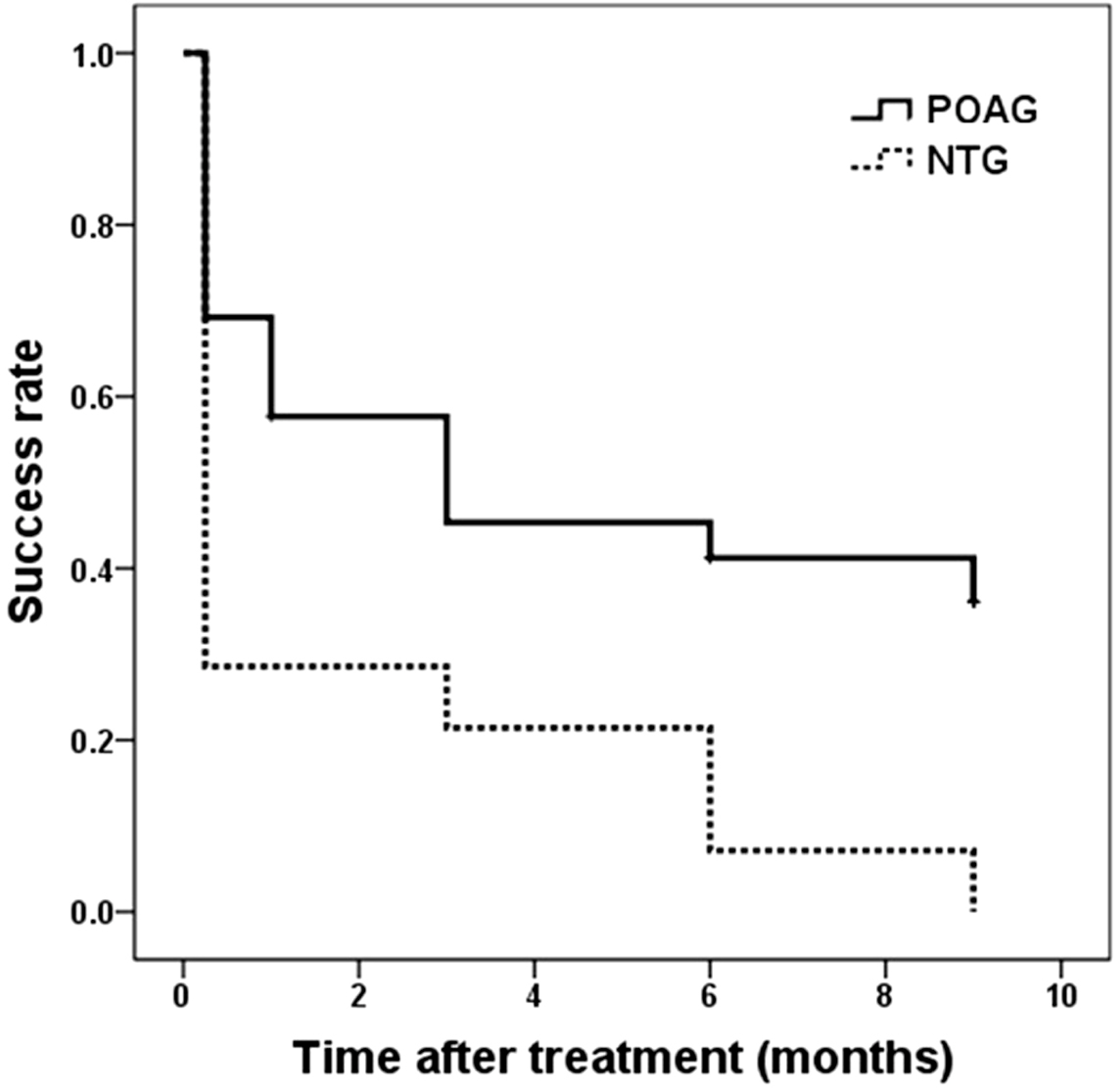J Korean Ophthalmol Soc.
2013 Dec;54(12):1862-1867.
Pattern Laser Trabeculoplasty Intraocular Pressure Reduction Efficacy in Open-Angle Glaucoma Patients on Medical Therapy
- Affiliations
-
- 1Department of Ophthalmology, Ulsan University Hospital, University of Ulsan College of Medicine, Ulsan, Korea. yimjinho@hanmail.net
Abstract
- PURPOSE
To assess the effectiveness and safety of Pattern Laser Trabeculoplasty (PLT) in patients with primary open-angle glaucoma (POAG) and normal tension glaucoma (NTG).
METHODS
Twenty-six eyes in patients with POAG and 14 eyes in patients with NTG were targeted in this study. The intraocular pressure (IOP) for each patient needed to be reduced within proper ranges. The clinical outcome was assessed by IOP at 1 week, 1 month, 3 months, 6 months and 9 months after PLT.
RESULTS
The mean (+/- standard deviation) IOP in the POAG group was 20.7 +/- 4.1 mm Hg before treatment. After PLT, the IOPs in POAG group were 16.4 +/- 3.1 mm Hg, 16.9 +/- 3.8 mm Hg, and 16.5 +/- 5.2 mm Hg at 1, 6 and 9 months, respectively, and the pressure remained stabled over 9 months of post-procedural follow-up. However, no statistical difference in IOP reduction was observed in the NTG group before and after treatment.
CONCLUSIONS
PLT provides a possibility to decrease additional medical therapy in patients with POAG. In addition, PLT can be considered as an auxiliary therapy for POAG patients who tolerate maximal medical therapy prior to undergoing surgical treatment.
MeSH Terms
Figure
Reference
-
References
1. Schwartz GF, Quigley HA. Adherence and persistence with glau-coma therapy. Surv Ophthalmol. 2008; 53:S57–68.
Article2. Nordstrom BL, Friedman DS, Mozaffari E. . Persistence and adherence with topical glaucoma therapy. Am J Ophthalmol. 2005; 140:598–606.
Article3. Wise JB, Witter SL. Argon laser therapy for open-angle glaucoma: a pilot study. Arch Ophthalmol. 1979; 97:319–22.4. Glaucoma Laser Trial Research Group. The Glaucoma Laser Trial (GLT) and glaucoma laser trial follow-up study: 7. Results. Am J Ophthalmol. 1995; 120:718–31.5. Kass MA, Heuer DK, Higginbotham EJ. . The Ocular Hypertension Treatment Study: a randomized trial determines that topical ocular hypotensive medication delays or prevents the onset of primary open-angle glaucoma. Arch Ophthalmol. 2002; 120:701–13.6. Latina MA, Sibayan SA, Shin DH. . Q-switched 532-nm Nd:YAG laser trabeculoplasty (selective laser trabeculoplasty): A multicenter, pilot, clinical study. Ophthalmol. 1998; 105:2082–90.7. Kramer TR, Noecker RJ. Comparison of the morphologic changes after selective laser trabeculoplasty and argon laser trabeculoplasty in human eye bank eyes. Ophthalmol. 2001; 108:773–9.
Article8. Damji KF, Shah KC, Rock WJ. . Selective laser trabeculo-plasty vargon laser trabeculoplasty: a prospective randomised clin-ical trial. Br J Ophthalmol. 1999; 83:718–22.9. Grač ner T. Intraocular pressure response to selective laser trabecu-loplasty in the treatment of primary open-angle glaucoma. Ophthalmol. 2001; 215:267–70.10. Blumenkranz MS, Yellachich D, Andersen DE. . Semiautomated patterned scanning laser for retinal photocoagulation. Retina. 2006; 26:370–6.
Article11. Jain AT, Blumenkranz MS, Paulus Y. . Effect of pulse duration on size and character of the lesion in retinal photocoagulation. Arch Ophthalmol. 2008; 126:78–85.
Article12. Paulus YM, Jain A, Gariano RF. . Healing of retinal photo-coagulation lesions. Invest Ophthalmol Vis Sci. 2008; 49:5540–5.
Article13. Al-Hussainy S, Dodson PM, Gibson JM. Pain response and follow-up of patients undergoing panretinal laser photocoagulation with reduced exposure times. Eye. 2008; 22:96–9.
Article14. Turati M, Gil-Carrasco F, Morales A. . Patterned laser trabeculoplasty. Ophthalmic Surg Lasers Imaging. 2010; 41:538–45.
Article15. Schuele G, Rumohr M, Huettmann G, Brinkmann R. RPE damage thresholds and mechanisms for laser exposure in the micro-second-to-millisecond time regimen. Invest Ophthalmol Vis Sci. 2005; 46:714–9.
Article16. Damji KF, Bovell AM, Hodge WG. . Selective laser trabeculo-plasty versus argon laser trabeculoplasty: results from a 1-year randomised clinical trial. Br J Ophthalmol. 2006; 90:1490–4.
Article17. Latina MA, Park C. Selective targeting of trabecular meshwork cells: in vitro studies of pulsed and CW laser interactions. Exp Eye Res. 1995; 60:359–71.
Article18. Nagar M, Ogunyomade A, O'Brart DP. . A randomised, pro-spective study comparing selective laser trabeculoplasty with lata-noprost for the control of intraocular pressure in ocular hypertension and open angle glaucoma. Br J Ophthalmol. 2005; 89:1413–7.
Article19. Melamed S, Ben Simon GJ, Levkovitch-Verbin H. Selective laser trabeculoplasty as primary treatment for open-angle glaucoma: a prospective, nonrandomized pilot study. Arch Ophthalmol. 2003; 121:957–60.
- Full Text Links
- Actions
-
Cited
- CITED
-
- Close
- Share
- Similar articles
-
- The Effect of 1 % Apraclnidine on Intraocular Pressure Following Argon Laser Iridotomy and Laser Trabeculoplasty
- Clinical Result of Argon Laser Trabeculoplasty in Primary Open Angle Glaucoma
- Two-year Follow-up of Selective Laser Trabeculoplasty as Initial and Adjunctive Treatment for Ocular Hypertension and Open Angle Glaucoma
- Short-Term Clinical Outcomes of Laser Trabeculoplasty Using a 577-nm Wavelength Laser
- Effect of Prior Cataract Surgery on the Clinical Outcome of Selective Laser Trabeculoplasty




